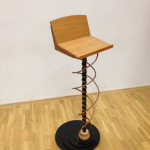In traditional maasai society, children are an asset the family enterprise in so many ways. As well as being loved for who they are, they are celebrated as the future of the family, as well as vital to its effective functioning. We have seen what we would call tots, barely three of four years old, out in remote places looking after the sheep and goats. As they grow, the children take on more and more responsibility and more arduous tasks. The girls fetching and carrying heavy loads of water and firewood, and helping their mothers in the construction and maintenance of the traditional mud houses. The boys trecking with the livestock, and taking on the more complex and arduous cattle watering, grazing, and livestock care.
So when education beckons, it can be hard for some traditional families to release children to go.


We heard a heart rending story from a volunteer at the school, who came across a girl carrying firewood just like in these pictures that we took on our game walk with John. The volunteer asked the girl didn’t she want to go to school. In reply, the girl said nothing, but tears simply streamed down her cheeks. The volunteer made her drop her load, climb into her car, and took her to the teachers to talk with the parents for her to enrole. The girl, Nasiaku, is now in class full time.
Yet the joining of the old and the new in this way is not always easy. John ole Mpoe chairs the school committee, which run a rescue programme for girls and boys that want to come to school, and which are prevented from doing so by their parents. They patiently explain to the parents the benefits that education can bring, for example, with girls going on to be nurses, social workers and teachers themselves, bringing local employment, and allowing the community to cater for and care for its own, rather than relying on officials from outside areas.
Yet some parents will remain stubborn, and refuse. In some cases, arranged marriages of what in the west would be under-age girls still goes on. In these cases, and where parents still do not listen to reason, the school will bring in the administration or police to resolve the issues.
Except perhaps at times of drought, when all hands may be needed on deck to move cattle, and the school is understanding, generally, parents are seeing the benefits of progress, and enrolment rates continue to rise.


































